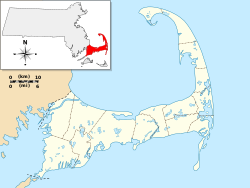Aptucxet Trading Post
In 1627, English colonists from Plymouth Colony established a trading post 20 miles (32 km) south of Plymouth at Aptucxet on the Manamet River (also known as the Manomet [2] [3] or Monument [2] River) on upper Cape Cod. The post was the colonists' first permanent settlement on Cape Cod, [3] although they had previously visited the Manamet River area to trade for corn and beans [3] and to search for a missing colonist. [4] [5] The name Aptucxet is a Wampanoag word meaning "little trap in the river", possibly referring to a fishing weir. [6]
The post was established primarily to trade with the Wampanoags, which was desirable for the colonists for several reasons. The colony relied in part on corn and beans supplied by the Indians, and some colonists hoped to start a fur trade in order to repay their debts to England. The trading post also came to be used for trade between the English colonists and the Dutch colonists of New Amsterdam to the south, today New York City. [3] [5] [7]
Aptucxet was the first trading post established by the Plymouth colonists, and it was followed in 1633 by the Metteneque Trading Post in Windsor Locks, Connecticut [8] and the Cushnoc Trading Post in Augusta, Maine. Aptucxet was located some distance from the colony and was staffed year-round by colonists. The Great Colonial Hurricane of 1635 damaged one of the buildings, and the post was abandoned by the 1650s. The land later became part of a farm. [5] [7]
The first archaeological dig on the property was conducted in 1852 when John Batchelder and William Russell undertook a partial excavation of a double cellar hole foundation. [7] [5] They believed that the foundation was part of the original Aptucxet Trading Post, although some researchers have suggested that it may have belonged to a later building. [7] The Bourne Historical Society acquired the land in 1922, and a thorough excavation was conducted between 1926 and 1929 by Percival Hall Lombard and Nathan Bourne Hartford. The current replica building was constructed in 1930 upon these original foundations, using findings from the archaeological digs. [7] [5]
The Manamet and Scusset Rivers were widened early in the 20th century and connected to form the Cape Cod Canal, following a route very similar to the one used by Plymouth colonists to travel to the Aptucxet Trading Post. [2] [3] Consequently, the Aptucxet Trading Post Museum is now located on the banks of the Cape Cod Canal rather than the Manamet River.
This page is based on this
Wikipedia article Text is available under the
CC BY-SA 4.0 license; additional terms may apply.
Images, videos and audio are available under their respective licenses.




